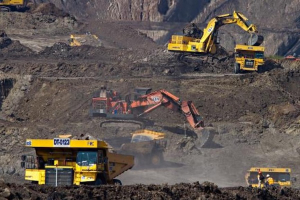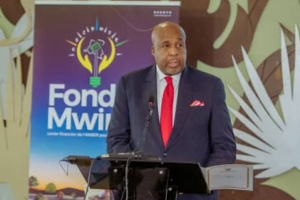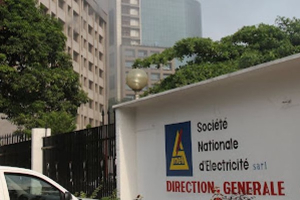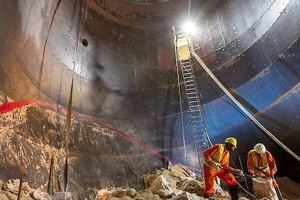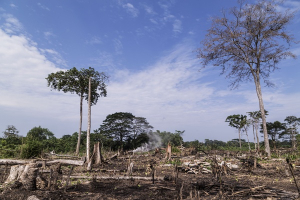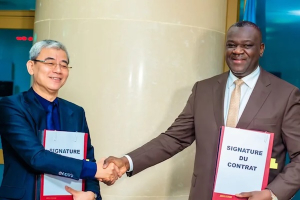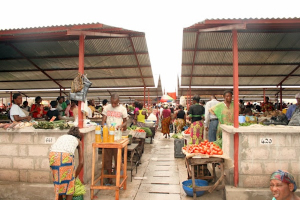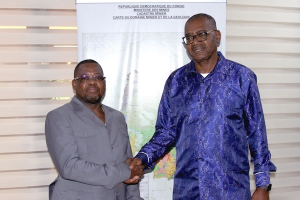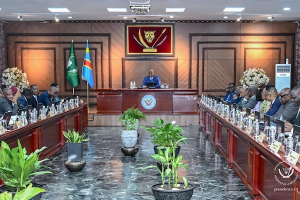Equipe Publication
Mine de cuivre-cobalt de Molulu : NIU contrôle désormais 70% de Critical Metals
La société d’investissement NIU Invest SE a porté sa participation dans Critical Metals Plc à 69,62 %, selon un communiqué de l’opérateur du projet cuprifère et cobaltifère Molulu, situé à environ 100 km au nord de Lubumbashi, dans le Haut-Katanga. À l’issue de cette opération, NIU détient désormais 70,8 millions d’actions ordinaires, représentant la majorité du capital de l’entreprise.
Le projet Molulu est présenté comme une petite mine de cuivre et de cobalt encore en phase de structuration. « Notre exploitation minière est très rudimentaire », expliquait en 2024 le directeur général de Critical Metals, Russell Fryer. « Il s'agit d'une exploitation très simple, avec camion et pelle, visant à produire 10 000 tonnes de minerai de cuivre par mois. Nous retirons la couche d'oxyde, la chargeons dans des camions, puis expédions le minerai à Lubumbashi, à 100 km au sud de notre site, pour traitement. »
La société prévoit d’acquérir un concentrateur afin d’améliorer la teneur du minerai et de réduire les coûts de transport.
NIU Invest SE, dirigée par l’investisseur autrichien Cevdet Caner, est une société d’investissement active en Europe et aux États-Unis, avec l’ambition de devenir un opérateur minier intégré disposant d’actifs en Amérique du Nord, en Amérique latine, en Afrique et en Europe. Le renforcement de sa participation dans Critical Metals illustre cette stratégie d’expansion.
Cette montée au capital intervient un mois après une première opération, en août 2025, qui avait porté la participation de NIU à 60,34 % par le biais d’une souscription à 61,4 millions de nouvelles actions ordinaires. Cette prise de contrôle avait fait de NIU l’actionnaire majoritaire, devant la Bank of New York.
En consolidant sa position, NIU confirme sa confiance dans le potentiel du projet Molulu, malgré une situation financière difficile, marquée par des pertes et un fort endettement. Critical Metals a indiqué travailler sur des mesures de réduction des coûts et d’amélioration de la rentabilité afin de stabiliser ses opérations.
Timothée Manoke
Lire aussi :
Mine de Kalukundi : la Gécamines porte sa participation à 49 % grâce à l’accord avec ERG
L’Émirati NG9 Holding intéressé par les projets de Buenassa Resources et Kipay Energy en RDC
Raffinerie cuivre-cobalt : la RDC entre au capital de Buenassa, un pas vers la levée de fonds
Fonds Mwinda : un premier appel à projets pour électrifier les campagnes
Le 17 septembre 2025, à Kinshasa, le ministre des Ressources hydrauliques et de l’Électricité, Aimé Sakombi Molendo, a lancé le premier appel à projets du Fonds Mwinda, mécanisme financier national destiné à accélérer l’électrification rurale et périurbaine. L’objectif est de soutenir des initiatives adaptées aux réalités locales, capables d’apporter des changements rapides et visibles dans la vie des communautés.
Le Fonds Mwinda repose sur quatre instruments : des subventions de démarrage pour stimuler l’offre initiale, des subventions basées sur les résultats afin de récompenser l’impact réel sur l’accès à l’électricité, des mécanismes de partage des risques pour lever les barrières à l’investissement privé, et des appels à projets compétitifs pour financer les solutions les plus viables.
Les technologies visées incluent les systèmes solaires domestiques, les mini-réseaux solaires ou hybrides, l’hydroélectricité locale, les foyers améliorés et les solutions de cuisson propre, ainsi que l’électrification d’infrastructures sociales telles que hôpitaux, écoles et marchés.
Avec un taux d’électrification national autour de 21 %, qui chute à 2 % en milieu rural où vit 80 % de la population, la RDC place ce fonds au cœur de sa stratégie pour porter l’accès à l’électricité à 60 % d’ici 2030.
Depuis la création de l’Agence nationale de l’électrification et des services énergétiques en milieux rural et périurbain (ANSER) en 2020, dotée d’une capitalisation initiale de 5 millions de dollars par l’État, le Fonds Mwinda a déjà mobilisé environ 90 millions de dollars. Parmi ses principaux partenaires figurent la Banque mondiale (63 millions pour des subventions basées sur la performance et 20 millions pour les solutions de cuisson propre), la Global Energy Alliance for People and Planet (7,3 millions) et le PNUD (260 000 dollars pour des projets pilotes).
L’objectif reste toutefois de lever entre 500 millions et 1 milliard de dollars pour une électrification à grande échelle. Pour rassurer les bailleurs, la Banque mondiale a recruté la société GreenMax afin de garantir la transparence et l’efficacité de la gestion des financements.
Ce premier appel à projets s’inscrit dans la continuité des phases déjà mises en œuvre. En 2021, la phase pilote avait permis d’électrifier 3 000 ménages grâce à des systèmes solaires individuels. En 2022, la phase intermédiaire avait touché 25 000 ménages dans 49 territoires, distribué 20 000 foyers améliorés et électrifié une vingtaine de centres de santé, tout en lançant des projets pilotes d’accès à l’eau potable.
Timothée Manoke
Lire aussi :
Électricité : la production de la RDC en hausse de 303 GWh en 2024, mais des défis persistent
Biogaz : la stratégie de la RDC pour produire 1,5 milliard de Nm³ d’ici 2030
Électricité : la RDC vise 19,5 milliards $ d’investissements privés d’ici 2030
SNEL : le démembrement abandonné après une manifestation du personnel
Le conseil d’administration de la Société nationale d’électricité (SNEL) a annoncé, dans un communiqué publié le 16 septembre 2025, qu’il mettait un terme aux « réflexions sur le projet de dégroupage des activités de la société en filières ». Sans en préciser les raisons, le document souligne toutefois que « les représentants des travailleurs seront impliqués dans toutes réflexions stratégiques ».
Cette volte-face intervient après une manifestation du personnel organisée le 9 septembre dans l’enceinte de l’entreprise à Kinshasa. Selon l’Agence congolaise de presse (ACP), agents et cadres dénonçaient le projet de démembrement de la société en trois entités distinctes : SNEL Production, SNEL Transport et SNEL Commerciale.
Le conseil d’administration a également tenu à rassurer sur les rumeurs de privatisation, affirmant que celles-ci sont infondées : « Aucune décision, ni initiative, visant à envisager la cession partielle ou totale du capital de la SNEL n’a été prise ni instruite, ni par l’État actionnaire unique, ni par le conseil d’administration », peut-on lire dans le communiqué.
Le projet de démembrement de la SNEL s’inscrivait pourtant dans les réformes prévues par le Compact énergétique conclu entre le gouvernement et ses partenaires. Cette feuille de route vise à accroître le taux d’accès à l’électricité en République démocratique du Congo, actuellement de 21 %, pour le porter à plus de 60 % d’ici 2030, et à permettre à l’entreprise publique de recouvrer 100 % de ses coûts opérationnels d’ici 2029. La privatisation de la société n’y est en revanche pas mentionnée.
La Banque mondiale, qui soutient cette réforme, estime que le découpage de la SNEL permettrait d’améliorer la transparence, d’assurer un suivi plus rigoureux des performances et d’identifier les défis propres à chaque activité. L’objectif affiché est de transformer « la SNEL en une entreprise forte et durable », condition préalable à la mise en œuvre du programme Grand Inga, projet de centrale hydroélectrique d’un potentiel de 42 000 MW nécessitant plusieurs milliards de dollars de financement. Une meilleure santé financière de la SNEL, souvent critiquée pour ses pertes techniques et commerciales dues à la vétusté du réseau et à un faible taux de recouvrement des factures, est jugée essentielle pour garantir la confiance des bailleurs et la récupération des fonds investis.
Timothée Manoke
Lire aussi :
SNEL : comprendre le projet de démembrement contesté par le personnel
Ivanhoe Mines secures $500 mln investment from Qatar sovereign fund
-
Qatar Investment Authority to acquire 4% stake in Ivanhoe Mines.
-
Deal worth $500 mln awaits Toronto Stock Exchange approval.
-
Funds to support copper, zinc projects in DRC and global exploration.
Ivanhoe Mines said on Sept. 17 it had struck a deal with Qatar’s sovereign wealth fund for a $500 million investment. The agreement gives the Qatar Investment Authority (QIA) a 4% stake in the Canadian miner through the purchase of 57.5 million shares.
The private placement is pending approval by the Toronto Stock Exchange. Ivanhoe’s top shareholders, CITIC Metal Africa Investments and Zijin Mining Group, retain the right to acquire shares at the same price as QIA to keep their level of participation.
QIA chief Mohammed Saif Al-Sowaidi said the investment reflected confidence in Ivanhoe’s assets and its role in supplying minerals for the energy transition. "This strategic investment reflects QIA's belief not only in Ivanhoe Mines' world-class portfolio of assets, but more importantly in supporting its team to find, develop and sustainably supply the minerals essential to the global energy transition and advanced technology applications," he said.
Ivanhoe claimed it plans to channel the funds into exploration and mining projects. In the Democratic Republic of Congo, the TSX-listed firm owns 39.6% of the Kamoa-Kakula copper mine, the country’s largest copper mine, and 62% of the Kipushi zinc mine. Ivanhoe operates both projects.
PM with Ecofin Agency
Est de la RDC : 19 millions $ pour soutenir la résilience agricole face au changement climatique
La République Démocratique du Congo (RDC) prépare la mise en œuvre d’un projet quinquennal baptisé Croissance résiliente et adaptation au changement climatique en RDC, destiné à renforcer la résilience climatique dans les provinces de l’Est. D’un coût de près de 19 millions de dollars, ce programme est cofinancé par le gouvernement et ses partenaires, dont le Fonds pour les pays les moins avancés (FPMA) du Fonds pour l'environnement mondial (FEM), qui a récemment accordé à la RDC un financement de 8,24 millions de dollars.
L’initiative sera déployée dans le Nord-Kivu, le Sud-Kivu et le Maniema, trois provinces marquées par la fragilité de leurs écosystèmes forestiers et une forte vulnérabilité aux effets du changement climatique. Elle prévoit d’accompagner environ 30 000 personnes, dont 50 % de femmes, en renforçant la résilience du secteur agricole et en soutenant les communautés locales, y compris les peuples autochtones et pygmées.
Le projet ambitionne de déployer des pratiques agricoles durables sur 15 000 hectares, notamment par la distribution de semences améliorées et la formation de plus de 500 agriculteurs principaux. Ces actions visent à mieux préparer les exploitants aux aléas climatiques tels que sécheresses, inondations ou précipitations irrégulières. Une attention particulière sera portée à l’entrepreneuriat féminin et juvénile, grâce à un accompagnement technique et financier pour développer des modèles d’affaires dans la transformation et la commercialisation des produits agricoles.
Ce projet s’inscrit dans la continuité des engagements climatiques du pays, en cohérence avec le Plan national d'adaptation (PAN) et la contribution déterminée au niveau national (CDN) dans le cadre de l’Accord de Paris. Il contribue également aux objectifs de développement durable, en s’attaquant aux causes profondes de la vulnérabilité, telles que la dégradation des écosystèmes, la faiblesse institutionnelle et le manque d’opportunités économiques.
Boaz Kabeya
Lire aussi :
Réduction des émissions de carbone : la RDC reçoit une récompense de 19, 47 millions $
La RDC prépare une réforme des PPP pour y intégrer les enjeux climatiques
Changements climatiques : 200 millions $ pour la prévention et la gestion des risques en RDC
RDC-FMI : feu vert pour le nouveau programme de près de 3 milliards de dollars
Identification numérique : Trident lève 2,6 millions $ pour déployer le DRCPass
Dans un communiqué publié le 16 septembre 2025, Trident Digital Tech Holdings Ltd a annoncé avoir levé 2,6 millions de dollars. Ces fonds, précise la société basée à Singapour, « seront principalement utilisés pour soutenir l’expansion et la commercialisation du DRCPass en République démocratique du Congo (RDC) », après déduction des frais liés à l’opération.
Le DRCPass constitue le système national d’identification numérique de la RDC. Son déploiement se fera par phases, dans le cadre d’un contrat de partenariat public-privé signé le 19 juin 2025 à Kinshasa entre Trident et le gouvernement congolais. L’accord confère à l’entreprise le rôle de fournisseur exclusif des services électroniques d’identification (e-KYC) de la République, reposant sur les technologies Web 3.0.
Selon un communiqué du ministère du Numérique daté du 26 juin, le lancement officiel du système doit être précédé d’un audit technique et de conformité réglementaire, de tests pilotes restreints pour garantir robustesse et sécurité, ainsi que d’une campagne de communication nationale. Fin juin, l’audit était encore en cours et, depuis, aucune information supplémentaire n’a filtré. On peut néanmoins constater que la campagne de sensibilisation n’a pas encore débuté.
La méthode retenue pour lever les fonds laisse cependant penser que Trident agit dans une certaine urgence. L’opération a été réalisée via un Private Investment in Public Equity (PIPE), mécanisme permettant de mobiliser rapidement des capitaux sans recourir à une émission publique longue. Elle a été structurée par Chaince Securities, agent de placement exclusif et filiale de Mercurity Fintech Holding, également cotée au Nasdaq, tout comme Trident.
D’après Chaince, les fonds ont été obtenus grâce à l’émission et la vente d’actions ordinaires de classe B (dotées de droits de vote réduits). Celles-ci ont été souscrites par des investisseurs institutionnels, dont l’identité n’a pas été révélée, via des accords d’achat et d’enregistrement de titres. Conformément aux engagements pris, Trident devra déposer une déclaration d’enregistrement de revente auprès de la Securities and Exchange Commission (SEC) des États-Unis.
Le système d’identification numérique DRCPass repose sur quatre usages prioritaires. Il permettra une authentification biométrique des cartes SIM, liée à une identité citoyenne vérifiée par blockchain, afin d’éliminer les lignes fictives et de réduire les fraudes. Il donnera aussi un accès simplifié aux plateformes d’e-gouvernement et aux services en ligne grâce à un identifiant unique (SSO). Sur le plan financier, il proposera une solution d’e-KYC en un clic, avec évaluation automatique du risque et ouverture immédiate à des services de crédit, favorisant ainsi l’inclusion financière. Enfin, il servira de pièce d’identité numérique sécurisée, complémentaire aux documents physiques, pour les transactions publiques et privées.
Pierre Mukoko et Ronsard Luabeya
Petit commerce en RDC : les étrangers interdits d’activité dès novembre 2025
Le ministre de l’Économie nationale, Daniel Mukoko Samba, a annoncé, le 16 septembre 2025, la fin du moratoire autorisant les étrangers à exercer dans le secteur du petit commerce en République démocratique du Congo (RDC). La mesure prendra effet dès novembre 2025.
Lors d’une rencontre avec les opérateurs économiques à Kinshasa, Daniel Mukoko Samba a expliqué que cette décision vise à rétablir l’application de la loi de 1973, qui réserve le petit commerce aux Congolais. Selon lui, plusieurs décrets successifs avaient affaibli ce cadre légal, permettant à des étrangers de s’implanter dans des activités initialement réservées aux nationaux.
Pour corriger cette situation, le ministre a annoncé l’élaboration d’une nouvelle loi. « Il faut une loi moderne, claire et applicable, qui ne laisse plus place aux interprétations », a-t-il déclaré. Ce texte devra définir précisément le champ du petit commerce et mettre fin aux dérogations qui ont permis à des étrangers d’opérer dans certains segments.
Déjà, lors du Conseil des ministres du 5 août 2023, un projet de loi porté par l’ancien ministre Vital Kamerhe avait été adopté. Il fixait les principes généraux du secteur, confiait aux provinces la compétence exclusive pour organiser le commerce frontalier et intérieur, maintenait la patente comme taxe annuelle autorisant l’activité, et relevait le seuil de chiffre d’affaires mensuel applicable aux petits commerces.
En avril 2025, Daniel Mukoko Samba avait par ailleurs indiqué que le projet de loi spécifique en préparation devait clarifier les conditions d’exercice des différentes catégories de commerce et protéger les opérateurs congolais face à une concurrence étrangère jugée déloyale.
La loi n°73/009 du 5 janvier 1973 sur le commerce en RDC classe les activités commerciales en sept catégories : commerce de détail, de gros, de demi-gros, d’importation, d’exportation, de transit et services réputés commerciaux. Toutes ces activités sont réservées aux personnes physiques de nationalité congolaise ou aux sociétés de droit congolais.
Ronsard Luabeya
Concessions minières : le Kasaï mise sur le Cami pour mieux collecter la taxe de superficie
La province du Kasaï, connue pour ses activités diamantifères, s’apprête à renforcer la collecte de la taxe de superficie sur les concessions minières. Le 12 septembre 2025, le gouvernement provincial a signé avec le Cadastre minier (Cami), organe chargé de la gestion du domaine minier en République démocratique du Congo, un protocole d’accord sur l’encadrement de cette redevance.
Ce partenariat prévoit un appui technique et institutionnel du Cami, notamment en matière de perception des taxes, de partage des bases de données cadastrales et de formation du personnel provincial. L’initiative s’inscrit dans une stratégie visant à maximiser les recettes fiscales issues du secteur minier au profit de la province.
Pour le gouverneur du Kasaï, Crispin Mukendi, cet accord permettra à l’exécutif provincial de mieux exercer ses prérogatives et de capter davantage de retombées fiscales, contribuant ainsi à la gouvernance locale et à l’accroissement des recettes publiques.
Prévue par l’article 238 du Code minier de 2018, la taxe sur la superficie est due par les titulaires de permis de recherche et de droits miniers d’exploitation. Elle est calculée en fonction de l’étendue de la concession.
Les taux applicables aux permis de recherche sont fixés en francs congolais, sur la base d’une conversion équivalente en dollars américains : 0,2 dollar par hectare pour la première année, 0,3 dollar pour la deuxième année, 0,35 dollar pour la troisième année et 0,4 dollar pour la quatrième année et les suivantes.
Pour les droits miniers d’exploitation, les montants s’élèvent à 0,4 dollar par hectare pour la première année, 0,6 dollar pour la deuxième année, 0,7 dollar pour la troisième année et 0,8 dollar pour la quatrième année et les suivantes.
Ronsard Luabeya
DRC Moves to Suspend Exploitation of Precious Redwood
-
Environment Minister announced plans to suspend all exploitation of Padouk redwood, a species prized in luxury furniture.
-
The ban will cover cutting, transport, and sales nationwide, backed by new digital oversight and tighter controls.
-
The move comes ahead of COP30 as Kinshasa seeks to align forest governance with global standards and curb illicit logging.
The Democratic Republic of Congo (DRC) plans to suspend the exploitation of redwood, known locally as bois rouge. Environment Minister Marie Niange disclosed this at the Council of Ministers meeting on September 12. The measure, to be enacted by ministerial decree, will ban cutting, transport, and marketing of the wood across the country until further notice.
Niange said the suspension will be supported by stricter monitoring through the Programme de contrôle de la production et de la commercialisation des bois (PCPCB) and the rapid rollout of the Système intégré de gestion forestière (SIMEF), a digital one-stop shop for forest management.
The government hopes the decision will reassure international partners of its commitment to sustainable resource use. With COP30 approaching, Kinshasa aims to prove it can bring its forest governance in line with global standards while ensuring exploitation benefits the Congolese population.
Redwood is especially sought after in China for luxury furniture, according to environmental outlet Mongabay. Despite rules requiring special authorizations, illicit exploitation has been documented in recent years. Between 2013 and 2018, redwood was heavily logged in Haut-Katanga, prompting authorities to ban its exploitation there in 2018 and to secure its listing under the Convention on International Trade in Endangered Species of Wild Fauna and Flora (CITES).
A broader problem persists. A 2015 World Bank study estimated artisanal logging output in the DRC at 3 to 4 million cubic meters annually. Yet, figures from the Central African Forest Initiative (CAFI) show only 300,000 m³ came from industrial concessions, meaning over 90% of timber originates in the artisanal sector — often outside any legal framework.
Ronsard Luabeya
DRC Approves $8 Billion Sino-Congolese Industrial City After Delayed Negotiations
-
DRC Council of Ministers approves collaboration agreement for $8 billion Sino-Congolese Industrial City featuring 1,200 factories across 5,000 hectares
-
Industrial city forms part of massive $50 billion new city project on 43,000-hectare site in Maluku commune east of Kinshasa
-
Project targets 30,000 immediate jobs and 100,000 over 10 years
The Democratic Republic of Congo has cleared a major hurdle for its ambitious industrial development plans, with the Council of Ministers approving a collaboration agreement for the Sino-Congolese Industrial City on September 12, 2025. The Strategic Committee overseeing the broader Kinshasa extension project called the decision "momentous," paving the way for an official project launch within days.
The industrial city is part of a $50 billion initiative to build a new urban center on 43,000 hectares in Maluku commune, east of Kinshasa. The industrial zone will feature eight parks housing 1,200 factories across 5,000 hectares, plus a 2,000-hectare commercial district and 500-hectare workers' quarter, with total investment estimated at $8 billion according to Belgian newspaper L'Echo.
The 7,500-hectare site enjoys strategic access to the Congo River and the capital's main transportation arteries. Designated as a Special Economic Zone, it will offer tax and customs incentives to attract foreign and domestic investors focusing on agro-industry, manufacturing, and other production activities.
The agreement approval comes after significant delays. Construction was originally scheduled to begin in early 2025, but negotiations proved complex. A first version submitted to the Council of Ministers on July 18 was rejected, forcing revisions.
Details of the final agreement remain confidential, though it binds the DRC to Sino-Congo Special Economic Development Zone Sarl, the project company established by a Chinese consortium led by China State Construction Engineering. The implementation roadmap was also presented to ministers, but not made public.
Under previous timelines, development would proceed gradually from 2025-2026 with land preparation and basic infrastructure, followed by the first industrial units coming online from 2027, building to full capacity by 2030.
The project promises immediate creation of 30,000 direct jobs and over 100,000 positions within a decade. For the Congolese government, the industrial city represents a crucial diversification tool as minerals still account for over 90% of national exports. Officials hope the zone will develop sectors that add local value and broaden the tax base beyond resource extraction.
Pierre Mukoko





